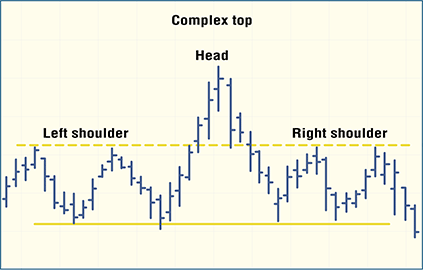Novice Traders’ Notebook
Cardinal Reversal Patterns — At Tops
7. The Complex Top
The complex top is a broad classification of somewhat irregular patterns that do not fit into any one of the other pattern definitions. One complex top pattern, the complex head-and-shoulders top, is one of the more symmetrical formations that fall into this group. The complex variety of head-and-shoulders tops consists of different numbers and combinations of shoulders and heads, rather than just one head and one each of left and right shoulders, as in the standard variety. The complex head-and-shoulders top occurs less frequently than the standard variety but has the same, if not better, reliability in warning of an impending downturn.

COMPLEX TOP. Here, we see one of the more symmetrical complex top patterns: the complex head-and-shoulders top. These patterns exist with multiple heads and shoulders, but the multiple shoulder with a single-head variety are a little more prevalent. In this formation, the number of shoulders on the left tends to be the same as the number on the right, and they usually form at a relatively equal price level.
The figure above shows a complex head-and-shoulders top with one head but two each of the left and right shoulders. Patterns also form with multiple heads, usually two, but such patterns are less common than the multiple-shoulder variation. Complex head-and-shoulders tops tend to be symmetrical; that is, these patterns have the same number of shoulders on both sides, but patterns with different numbers of shoulders on each side do occur. Like the standard head-and-shoulders pattern, the multiple shoulders in the complex pattern, as shown above, form at roughly the same price levels. The neckline is drawn connecting the valleys between the shoulders and head, and it is the price level, when broken to the downside, that indicates the completion of the formation.
Volume patterns in the complex head-and-shoulders top have not been consistently repeated, so volume is not definitive in confirming or contradicting the formation of this pattern.
— Stuart Evens